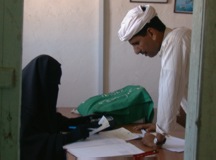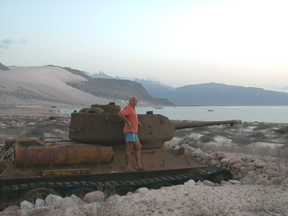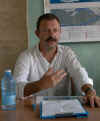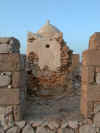Socotra

A spectacular sand dune at the anchorage -symbol of the near
desert conditions near the coast - the island is greener in the mountains
A quasi desolate island where most people live in near-mediaeval conditions. Many trek miles for their water, survive on a little rice and a few goats which in turn survive by eating anything and everything in the hope that some of it may be digestible. The main town, Hadibo, look like a bomb hit it. Trash is every where, small stone buildings lie half demolished - or perhaps half built. No roads are covered - except by thick white dust which kicks up with the rare wind. It is hot and most people are concerned with the basic needs. Religion is felt strongly - it must be an important crutch. The people are friendly and generous - and are only now getting used to western visitors.
 Ed Zandri's
secretary. He has yet to see her.
Ed Zandri's
secretary. He has yet to see her.
The island has a rich history. At one time it was an important gateway to the Red Sea and India. Colonists from Portugal and Arabs from Yemen and Oman fought fiercely for possession. In the end the Arabs won the war of attrition. The Portugese could not grow crops here and the islanders were hostile having taken up the Islamic faith and rejected their former Christianity.

Francois did find one wreck...
There are several very old ruins and Francois - a most adventurous Frenchman and crew of the UN dive ship Inga Viola - and I spent a couple days diving for a Portugese wreck and visiting the remains of the old Portugese fort looking for clues that might lead to Francois's greatest hope - finding a historic wreck.
 Crew of Inga Viola
plus Tom...
Crew of Inga Viola
plus Tom...
The people of Socotra seemed curious of Westerners and fascinated by modern sailboats. One feels safe here. If I could only speak some Arabic I am sure that the locals would have a lot of stories to tell about their history and life on the near-barren island.
 The UN
mission challenged the local champions - a Massacre!! (they won)
The UN
mission challenged the local champions - a Massacre!! (they won)
The UN mission is doing a remarkable job of paving the way for sustainable fishing and eco-tourism. Yemen, to which Socotra belongs, probably thinks of their presence as a lucrative Allah-send, but is also conscious that Socotra could one day have a viable economy and provide a better quality of life for its inhabitants. Yemen and the UN Mission are cooperating in the effort to identify the best areas to keep as marine reserves and other such zoning considerations. There is a general feeling that things are happening and that Socotra will undergo rapid development sometime soon. The German hotels are coming...
I met many of the UN people. Ed Zandri is the director of the project. He is spending five (5!) years on the island with his wife, Teresa, and a 2 month old baby.
1) Tom, in allenamento per una prossima apnea, 2) Ed e Teresa, 3) Tom dopo gli ormoni.
It must be said that all the UN people put up with a lot of discomfort - and some not insignificant health risks - to carry out their mission. Hats off to them - they are enthusiastic and hard working and will no doubt do a lot to preserve the state of the island's natural beauty whilst showing the residents how to better their lot. They have earned the respect and acceptance of the locals and that is a first important step.


 Dr Friedhelm Krupp, Dr. Catherine Cheung and Dr. Lyndon DeVantier plus
a local translator at A conference on Coral Reef Biodiversity attended by
many prominent islanders and decision makers from the Yemen mainland.
Dr Friedhelm Krupp, Dr. Catherine Cheung and Dr. Lyndon DeVantier plus
a local translator at A conference on Coral Reef Biodiversity attended by
many prominent islanders and decision makers from the Yemen mainland.
 Socotrans at the local market
Socotrans at the local market
Having said that, the main problem - lack of water - is a hard nut to crack. This is not Saudi Arabia where a couple of water desalinators would be shipped in over night. People are still digging holes in the ground to collect brackish water as their prime water source. An Italian student, misguidely sent here to research a thesis on "crop improvement" was near tears when he told me that there was nothing to research. "My entire thesis will read: 'There is no water. NO WATER! This leads to a significant problem when attempting to enrich or diversify farming...'".
Underwater Socotra has a notable amount of large fish and a remarkable variety of coral. However, growth is patchy and not extensive - perhaps due to the turbulence of the waters or the fact that the Island's cross-roads position leaves it in a sort of ecological no-man's land where no one set of conditions lasts long enough to sustain a constant cycle. This position does lead to coral spores arriving from many different directions - a good thing for Biodiversity. I got the impression that the island group could be particularly attractive as a diving destination but it would take a lot more exploration. Anyhow, it is all in the marketing...the competition from other diving paradises is tough.
 Local home in Ruins (or unfinished?)
Local home in Ruins (or unfinished?)
 Back from market.
Back from market.
Anyhow. I spent a great 10 days on island and thoroughly enjoyed the company of the Inga Viola, Ed, Teresa, Lyndon, Catherine and all the others. Hopefully we shall all meet again. Thank you so much Mark Gentili for making this visit possible.
And now it's back on my horse and westwards to Djibouti...
|
|


